The NVIDIA Turing GPU Architecture Deep Dive: Prelude to GeForce RTX
by Nate Oh on September 14, 2018 12:30 PM ESTRay Tracing 101: What It Is & Why NVIDIA Is Betting On It
Because one of the two cornerstone technologies of the Turing architecture is NVIDIA’s ray tracing RT cores, before we dive too much into the Turing architecture, it’s perhaps best to start with a discussion on just what ray tracing is. And equally important, why NVIDIA is betting so much silicon on it.
Ray tracing, in short, is a rendering process that emulates how light behaves in the real world. From a fundamental (but not quite quantum physics) level, light can be considered to behave like a ray. This is because photons, outside other influences, will travel in a straight line until they hit something. At which point various interactions (reflection, refraction, etc) occur between photons and the object.
The catch with ray tracing is that it’s expensive. Incredibly expensive. The scale of the problem means that if you take a naïve approach and try to calculate all of the rays of photons emitting from every light source in a scene, you’re going to be tracing an uncountable, near-infinite number of rays bouncing around a scene. It is essentially modeling all of the physical interactions of light within a bounded space, and that’s an incredible number of interactions.
As a result there have been a number of optimizations developed for ray tracing over the years. Perhaps the most important of which is sort of turning the naïve concept on its head, and instead of tracing rays starting from light sources, you instead go backwards. You trace rays starting from the point of the observer – essentially casting them out into a scene – so that you only end up calculating the light rays that actually reach the camera.
Such “reverse” ray tracing cuts down on the problem space significantly. It also means that conceptually, ray tracing can be thought of as a pixel-based method; the goal is to figure out what each pixel should be.
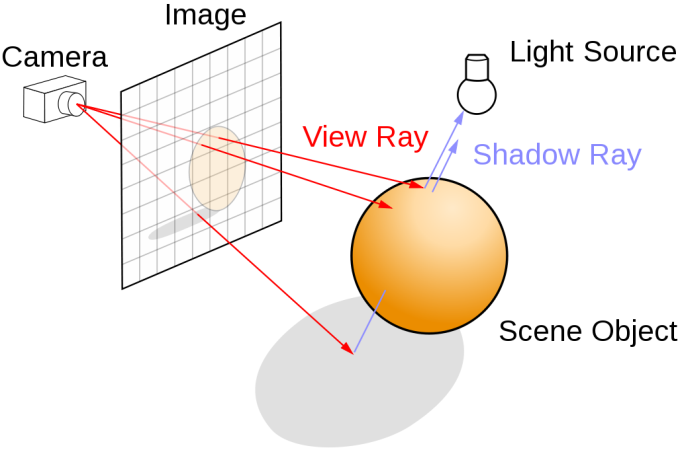
Ray Tracing Diagram (Henrik / CC BY-SA 4.0)
However even with this optimization and others, ray tracing is still very expensive. These techniques make ray tracing cheap enough that it can be done on a computer in a reasonable amount of time, where “reasonable” is measured in minutes or hours, depending on the scene and just how precise and clean you want the rendered frame to be. As a result, anything other than the cheapest, grainiest ray tracing has been beyond the reach of real-time rendering.
In practical terms then, up until now ray tracing has been reserved purely for “offline” scenarios, particularly 3D graphics in movies. The quality of ray tracing makes it second to none – it’s emulating how light actually works, after all – as it can accurately calculate reflections, shadows, light diffusion, and other effects to a degree of accuracy that no other method can. But doing all of this comes at a heavy cost.
Enter Rasterization: The World’s Greatest Hack
The high computational cost of ray tracing means that it hasn’t been viable for real-time graphics. Instead, since the earliest of days, the computing industry has turned to rasterization.
If ray tracing is a pixel-based approach, then rasterization would be called a polygon-centric approach to 3D rendering. But more than that, rasterization is a hack – a glorious hack to get around the fact that computers aren’t (or at least, weren’t) fast enough to do real-time ray tracing. Rasterization takes a number of shortcuts and makes a number of assumptions about how light, objects, and materials work in order to reduce the computational workload for rendering a scene down to something that can be done in real time.
Rasterization at its most basic level is the process of taking the polygons in a scene and mapping them to a 2D plane, the pixel grid. This means polygons are sorted and tested to see which polygons are actually visible, and then in various stages, these polygons are textured, shaded, and otherwise processed to determine their final color. And admittedly this is a gross simplification of a process that was already a simplification – I’m completely ignoring all the math that goes into transforming 3D objects into a 2D representation – but in an amusing twist of fate, the hack that is rasterization is in some ways more complex than the natural process of ray tracing.
The key point to rasterization is not so much how it works, but rather that it doesn’t use rays, and therefore it’s cheap. Very cheap. And better still, it can be done in parallel. As a result GPUs have arisen as incredible matrix multiplication machines, and are capable of testing hundreds of millions of polygons every second and coloring billions of pixels. With a few exceptions, rasterization is nice and orderly, allowing computational techniques like Single Instruction Multiple Data/Thread (SIMD/SIMT) to do the necessary processing with incredible efficiency.
The catch to rasterization is that because it’s a hack – however glorious it is – at the end of the day there are limitations to how well it can fake how vision and light work in the real world. Past basic polygon projection and texturing, pixel shading is where most of the work is done these days to actually determine what color a pixel needs to be. It’s in pixel shaders that the various forms of lighting (shadows, reflection, refraction, etc) are emulated, where distortion effects are calculated, etc. And pixel shaders, while powerful in their own right, are not capable of emulating real light to a high degree, at least not in a performant manner.
It’s these limitations that lead to the well-publicized drawbacks in rasterization. The unnatural light, the limited reflections, the low resolution shadows, etc. Now conceptually, it is by no means impossible to resolve these issues with rasterization. However the computational cost of doing so is very high, as the nature of rasterization is such that it’s difficult to bolt on such high accuracy methods on to what’s at its core a hack. Rasterization is meant to be quick & dirty, not accurate.
Ray Tracing Returns – Hybridization
Coming full-circle then, we reach the obvious question: if rasterization is so inaccurate, how are games meant to further improve their image quality? Certainly it’s possible to continue going down the road of rasterization, and even if the problem gets harder, image quality will get better. But keeping in mind that rasterization is a hack, it’s good to periodically look at what that hack is trying to achieve and whether that hack is worth the trade-offs.
Or to put this another way: if you’re going to put in this much effort just to cheat, maybe it would be better to put that effort into accurately rendering a scene to begin with?
Now in 2018, the computing industry as a whole is starting to ask just that question. Ray tracing is still expensive, but then so are highly accurate rasterization methods. So at some point it may make more sense to just do ray tracing at certain points rather than to hack it. And it’s this train of thought that NVIDIA is pursuing with great gusto for Turing.
For NVIDIA, the path forward is no longer pure rasterization. Instead their world view is one of hybrid rendering: combining the best parts of rasterization and compute with the best parts of ray tracing. Just what those parts are and where they should be done is a question ultimately up to developers, but at a high level, the idea NVIDIA is putting forth is to use ray tracing where it makes sense – for lighting, shadows, and everything else involving the interaction of light – and then using traditional rasterization-based methods for everything else.
This means that rather than immediately jumping from rasterization to ray tracing and losing all of the performance benefits of the former, developers can enjoy the best of both worlds, choosing how they want to balance the performance of rasterization with the quality of ray tracing. The examples NVIDIA and its partners have pitched thus far have been the low-hanging fruit – accurate real-time reflections, improved transparency, and better global illumination – but the use cases conceivably be extended to any kind of lighting-related operation. And perhaps, for the John Carmacks and Tim Sweeneys of the world, possibly something a lot more unorthodox.
With all of that said however, just because hybrid rasterization and ray tracing looks like a good idea on paper, that doesn’t mean it’s guaranteed to work well in practice. Certainly this initiative spans far more than just NVIDIA – Microsoft’s DXR API is a cornerstone that everyone can build from – however to call this the early days would be an overstatement. NVIDIA, Microsoft, and other companies are going to have to build an ecosystem essentially from scratch. And they’re not only going to have to sell developers on the merits of ray tracing, but they’re going to have to teach developers on how to implement it in an efficient manner. Neither of these are easy tasks. After all, ray tracing is not the only way forward, it’s merely one way forward. And, if you agree with NVIDIA, the most promising way forward.
But for today, let’s table the discussion of the merits of ray tracing. NVIDIA has made their move, and indeed the decisions that lead to Turing would have happened years ago. So instead, let’s take a look at how NVIDIA is going to transform their goals into reality by building hardware units specifically for ray tracing.


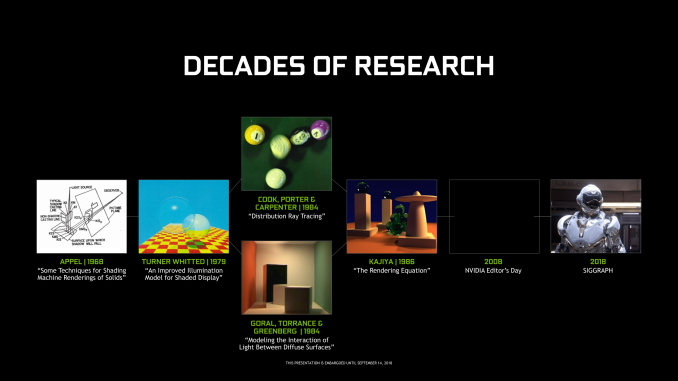
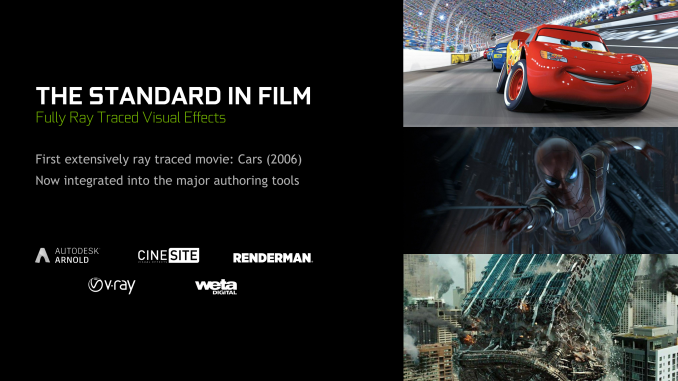
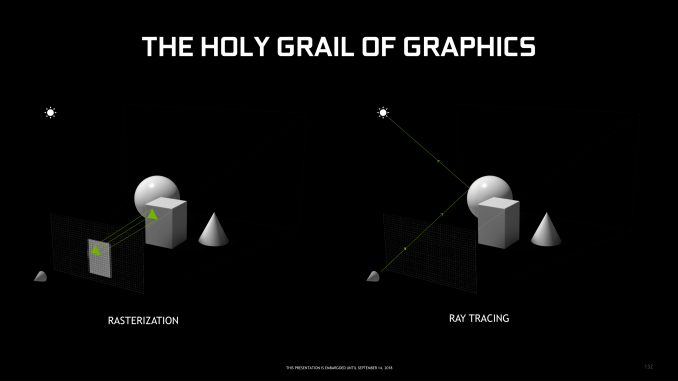
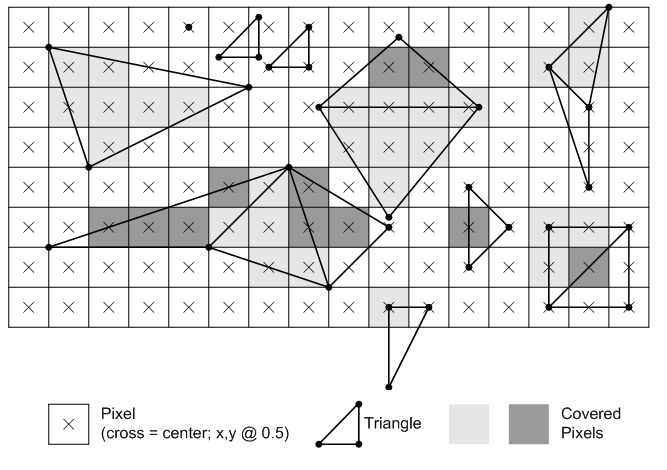
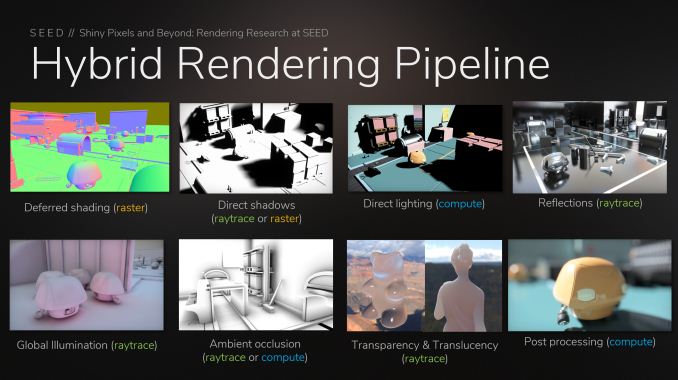








111 Comments
View All Comments
StormyParis - Friday, September 14, 2018 - link
Fascinating subject and excellent treatment. I feel informed and intelligent, so thank you.Gc - Friday, September 14, 2018 - link
Nice introductory article. I wonder if the ray tracing hardware might have other uses, such as path finding in space, or collision detection in explosions.The copy editing was a let down.
Copy editor: please review the "amount vs. number" categorical distinction in English grammar. Parts of this article, that incorrectly use "amount", such as "amount of rays" instead of "number of rays", are comprehensible but jarring to read, in the way that a computer translation can be comprehensible but annoying to read.
(yes: "amount of noise". no: "amount of rays, usually 1 or 2 per pixel". yes: "number of rays, usually 1 or 2 per pixel".) (Recall that "number" is for countable items, that can be singular or plural, such as 1 ray or 2 rays. "Amount" is for an unspecified quantity such as liquid or money, "amount of water in the tank" or "amount of money in the bank". But if pluralizable units are specified, then those units are countable, so "number of liters in the tank", or "number of dollars in the bank". [In this article, "amount of noise" does not refer to an event as in 1 noise, 2 noises, but rather to an unspecified quantity or ratio.] A web search for "amount vs. number" will turn up other explanations.)
Gc - Friday, September 14, 2018 - link
(Hope you're all staying dry if you're in Florence's storm path.)edzieba - Saturday, September 15, 2018 - link
" I wonder if the ray tracing hardware might have other uses, such as path finding in space, or collision detection in explosions."Yes, these were called out (as well as gun hitscan and AI direct visibility checks) in their developer focused GDC presentation.
edzieba - Saturday, September 15, 2018 - link
One thing that might be worth highlighting (or exploring further) is that raytraced reflections and lighting/shadowing are necessary for VR, where screen-space reflections produce very obviously incorrect resultsAchaios - Saturday, September 15, 2018 - link
Τhis is epic. It should be taught as a special lesson in Marketing classes. NVIDIA is selling fanboys technology for which there is presently no practical use for, and the cards are already sold out. Might as well give NVIDIA license to print money.iwod - Saturday, September 15, 2018 - link
Aren't we fast running to Memory Bandwidth bottleneck?Assuming we get 7nm next year at 8192 CUDA Core, that will need at least 80% more bandwidth, or 1TB/s. Neither 512bit memory nor HBM2 could offer that.
HStewart - Saturday, September 15, 2018 - link
I wondering when professional rendering packages support RTX - I personally have Lightwave 3D 2018 and because of Newtek's excellent upgrade process - I could see supporting it in future. I could see this technology do wonders for Movie and Game creations - reducing the dependency on CPU cpresYaleZhang - Saturday, September 15, 2018 - link
Increased power use is disappointing. Is the 225W TDP for 2080 the power used or the heat dissipated? If it's power used, then that would include the 27W power used by VirtualLink. So then the real power usage would be 198 W.willis936 - Sunday, September 16, 2018 - link
I've been in signal integrity for five years. I write automation scripts for half million dollar oscilloscopes. I love it. It's my jam. Why on god's green earth does nvidia think their audience cares about eye diagrams? They mean literally nothing to the target audience. They're not talking to system integrators or chip manufacturers. Even if they were a single eye diagram with an eye width measurement means next to nothing beyond demonstrating that they have an image of what a signal at a given baud rate should look like (it's unclear if it's simulated or taken from one of their test monkeys). If they really wanted to blow us away they could say something like they've verified 97% confidence that their memory interface/channel BER <= 1E-15 when the spec commands BER <= 1E-12 or something. It's just a jargon image to show off how much they must really know their stuff. It just strikes me as tacky.